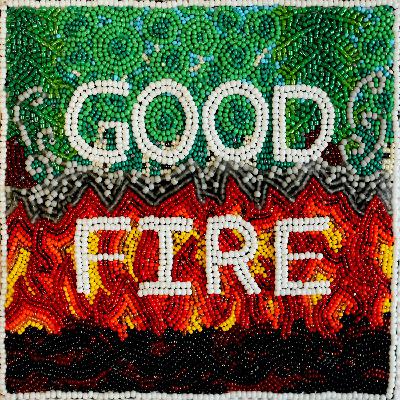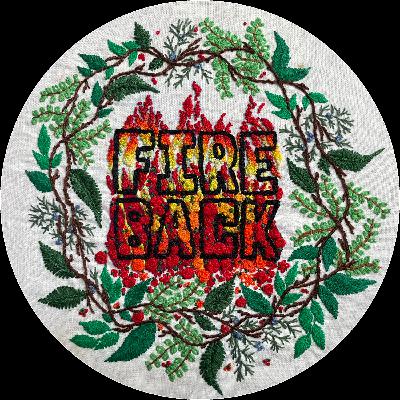Fire In Our DNA with Elizabeth Azzuz and Margo Robbins
Description
Good Fire Podcast by Amy Cardinal Christianson and Matthew Kristoff
Stories of Indigenous fire stewardship, cultural and social empowerment, and environmental integrity
Fire In Our DNA with Elizabeth Azzuz and Margo Robbins
Episode highlight
In this episode, Elizabeth Azzuz and Margo Robbins talk about restoring cultural fire in their tribal territory and across the world.
Resources
Cultural Fire Management Council
Elizabeth Azzuz
Margo Robbins
The California Endowment: Building Healthy Communities
Indigenous Peoples Burning Network
https://www.elementalfilm.com/
“Firelighters: Fire is Medicine” movie https://www.youtube.com/watch?v=AskCYsXWKpA&t=1s
Sponsors
Canada Wildfire
Indigenous Leadership Initiative
Quotes
05.06 - 5.27: “Fire has an amazing effect on not just the land and the health of the land and the resources that it produces but it is in fact a way to bring health back to our communities.”
05.57 - 06.07: “Fire is one of the ways to reconnect us to the land around us and our ancestors and our cultural lifeways.”
19.00 - 19.05: “It seems like, oftentimes, women are the movers and shakers in the community.”
Takeaways
Meet Elizabeth Azzuz (1.45)
Elizabeth Azzuz is a Yurok Tribe member, a descendent of the Karuk Tribe and has ties to the Metis Nation as well. She began burning at age 4 when her grandfather decided to teach her after watching her play with matches. She’s always loved what fire can do to restore the environment and provide food, medicine and basket materials. She takes great joy in training younger generations to carry this knowledge forward.
Meet Margo Robbins (02.57)
Margo Robbins is the executive director of Cultural Fire Management Council (CFMC) and is a member of the Yurok Tribe. As a basket weaver, she saw the tradition dying out because of regulations preventing cultural burning on their land, which is required to reproduce new single shoots of hazel needed for weaving the frames of baskets. She was about to become a grandmother and wanted her grandchildren to be carried in traditional baskets. So, she conveyed this to The California Endowment.
Loss of cultural identity (04.32)
As a CFMC cofounder, Margo realized that many young Indigenous people are losing their connection to their identity as Yurok people, which manifests in unhealthy behaviours like using drugs and alcohol. She emphasizes that working with fire is in their DNA as a people and their true calling. Before working in fire, she worked in the school system and used to include information on fire in her lessons as well. Now her focus is on restoring the land and helping other tribal people reclaim their fire traditions as well.
“We didn’t take no for an answer” (07.44)
Margo marvels at how the fire-creation stories of many different tribes have a lot in common. Margo had just finished her first burn in CFMC when she met Elizabeth who also expressed interest in joining. She narrates the story of how CFMC came to be, and how they have worked to make cultural burning possible now. They knew the dangers of fuel buildup and so recruited volunteers, developed a partnership with Nature Conservancy and conducted community training sessions to be allowed to burn.
Dual win (12.45)
After several years of burning on a volunteer basis, CFMC finally received a million-dollar wildfire prevention grant through CAL FIRE in 2019. With limited burn windows and specific burn schedules, they also did home protection and roadside clearance to provide full-time jobs to the employees. They chose places rich in cultural resources to burn so that they could provide “important cultural resources for the community while also providing wildfire protection in an area that is rated as extremely high fire risk”.
“A place that will be ours” (15.00)
Elizabeth shares that they recently purchased 140 acres for CFMC, a unit they have burned on a few times before, which is also close to Margo’s home. She is excited about the possibility of the first Indigenous fire training facility in California. Having their own space means they don’t have to borrow Tribal facilities, and they can bring on more staff. The two buildings that the property comes with have been assigned for training and parking fire engines, respectively.
Comfort in their territory (17.56)
Elizabeth believes the longevity and stability of the organization come from the women in the tribal community, evident in the common thought processes shared in the board meeting conversations. Margo quips about how they have had to shift gears many times to bring the training center dream to fruition. They built CFMC based on learnings from other organizations but created partnerships and terminology to cater to the needs and sensibilities of the Yurok people specifically.
“Happy and joyful” (23.23)
It makes Elizabeth happy to see the organization grow and expand in a natural way. Margo explains how they balance the needs of the government along with those of the tribes in doing a cultural burn. CFMC has created a seat at the decision-making table on prescribed fire, so they can share the cultural and ecological importance of burning. Margo ensures that the protocols and lines of command for safety don’t diminish their joy in working together with fire.
Putting medicine on the ground (26.58)
Margo points out that neither CALFIRE nor the US Forest Service lead their burns, and CFMC upholds the culture of the tribes in conducting the burn. Elizabeth adds that when they do a test fire, they open up their training with a prayer, asking permission from the land, animals, people, and the environment to restore their land, which sets the tone for the burn. Margo finishes the prayer with a song, which moves many people to tears.
Passing on the torch (30.14)
Elizabeth talks about CFMC’s Our Family Burns Program, which helps “Elders, single families, and community members create a space for themselves”. They teach the families to clear around their homes, create piles, and burn safely. Elizabeth finds it heartwarming to hear young people wanting to learn this to protect their family’s property. Including young students in their training is important to teach them to care for their environment and be safe.
Playing with fire (33.33)
Margo recalls when a wildfire started across her house many years ago, which traumatized her grandchildren. However, not wanting her grandchildren to be afraid of fire, she asked if they would like to burn with her. They went out into her yard, and she taught them about how fire works and how to burn safely using a little briar patch. They now have participated in 5-6 burns. She finds that since kids play with fire anyway, “it’s important for them to learn the responsible use of fire”.
“Unbalanced fir tree domination” (39.29)
Margo highlights that Douglas fir is native to their homelands and has a spiritual significance in ceremonies and dances. However, the ban on cultural burning and logging companies replanting fir trees densely caused a proliferation of fir trees and unbalanced the ecosystem. She uses fire to maintain that balance and to keep the grass healthy for human and non-human animals. Elizabeth laments that large logging industries use chemicals that poison water bodies and affect the health of the people.
Fighting on the planet’s side (43.21)
Elizabeth observes that Indigenous peoples who live in rural areas notice more in the environment than those in the cities and are more driven to fight the organizations destroying what they need to survive. Margo celebrates that using medical records of the cancerous effects of aerial sprays and providing alternatives to the toxins was successful in stopping them. They are in the process of negotiating air quality permits to allow them to increase the pace and scale of cultural burns to combat wildfires.
<p class="" styl















